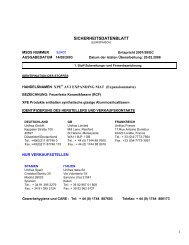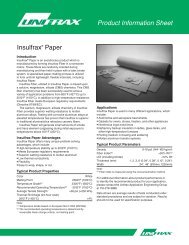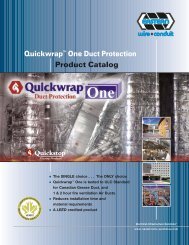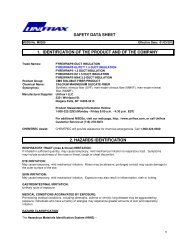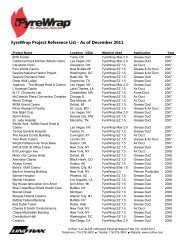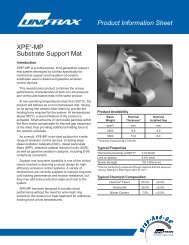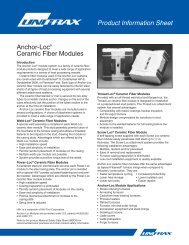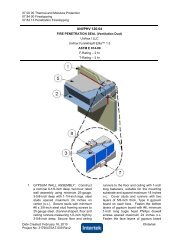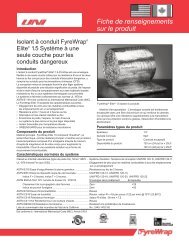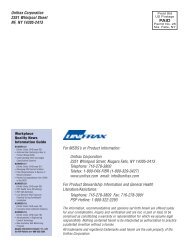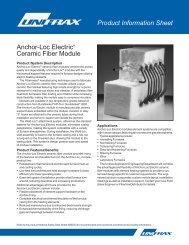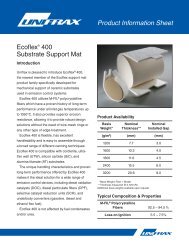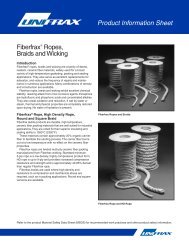Product Information Sheet - Unifrax
Product Information Sheet - Unifrax
Product Information Sheet - Unifrax
Create successful ePaper yourself
Turn your PDF publications into a flip-book with our unique Google optimized e-Paper software.
Fiberwall Ceramic Cuplocks<br />
When hot face temperatures exceed 1093°C (2000°F) but<br />
are below 1149°C (2100°F), the ceramic cuplock retainer can<br />
be employed to extend the recommended operating temperature<br />
of the 601 Inconel stud to 1149°C (2100°F). The alloy<br />
washer is not required when the cuplock is used to retain the<br />
insulation lining.<br />
The stud length dimension, when using a 2z cuplock<br />
retainer, is determined by subtracting 1z from the applicable<br />
lining thickness. For example, an 8z thick layered lining will<br />
require a 7z stud length when used with a 2z cuplock.<br />
Fiberwall Ceramic Bearing Ring<br />
The ceramic bearing ring is used in higher temperature<br />
layered lining applications, particularly on roofs, where added<br />
bearing support may be required. The bearing ring is used in<br />
conjunction with a cuplock, or ceramic washer. The maximum<br />
recommended operating temperature should be limited to<br />
1343°C (2450°F).<br />
Ceramic Bearing Ring<br />
2z Shank Ceramic Cuplock<br />
To be effective, the cuplock’s inner core must be filled with<br />
LDS moldable. This can be done either before or after engaging<br />
the cuplock to the stud’s tip.<br />
The 1z cuplock is used primarily in layered lining over<br />
refractory (L.O.R.) installations where lining thickness is usually<br />
2z or less, corrosive elements are present in the fuel, or when<br />
the hot face temperature is below 1121°C (2050°F).<br />
1z Shank L.O.R. Ceramic Cuplock<br />
Typically, the 1z cuplock is used in conjunction with barbed<br />
601 Inconel studs in L.O.R. applications. The “barb” of a<br />
barbed stud is configured so that it will easily enter within, but<br />
will lock securely to, predrilled holes in the refractory surface.<br />
LDS moldable is employed as a filler to plug the cuplock’s 1z<br />
deep core and, as in the 2z cuplock, is carried over to the face<br />
of the cuplock to effect a seal around the core’s perimeter edge.<br />
Fiberwall Ceramic Whistle Stud Assembly<br />
The ceramic whistle stud assembly is comprised of three<br />
distinct components: the adjustable whistle (or base), the<br />
high-alumina spike and the ceramic washer.<br />
The adjustable whistle base is a two-component, adjustable<br />
length system consisting of a whistle base (with retaining pin) and<br />
a ;z-20 NC x 1;z long arc welded stud. After the stud is arc<br />
stud welded to the casing plate, the whistle base is screwed<br />
onto the stud. This feature provides up to -z adjustment of the<br />
overall assembly length.<br />
The second component of the ceramic whistle stud assembly<br />
is the high-alumina ceramic spike which is available in seven<br />
standard lengths. The appropriate ceramic spike length for any<br />
given lining thickness is determined by referring to the charts<br />
shown on page 3. As indicated by the chart, the appropriate<br />
spike is defined by its “L2” dimension.<br />
The third component, the ceramic washer, is available<br />
in two ceramic compositions: high-alumina and mullite. Like<br />
the spike, the high-alumina washer’s recommended operating<br />
temperature extends to 1510°C (2750°F). The mullite ceramic<br />
washer’s maximum recommended operating temperature,<br />
while only 1343°C (2450°F), affords excellent resistance to<br />
thermal shock.<br />
Form C-1430<br />
Effective 8/09<br />
©2009 <strong>Unifrax</strong> I LLC<br />
All Rights Reserved<br />
Printed in USA<br />
Page 2 of 4



